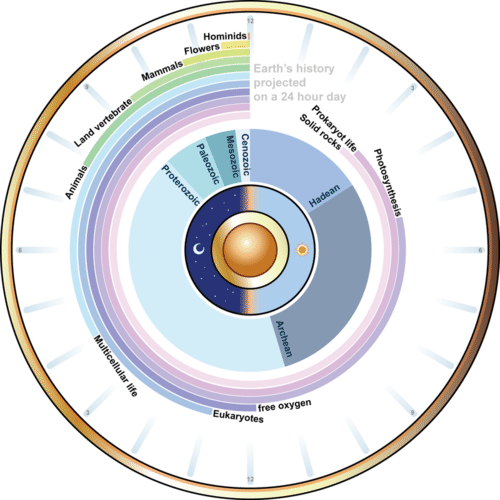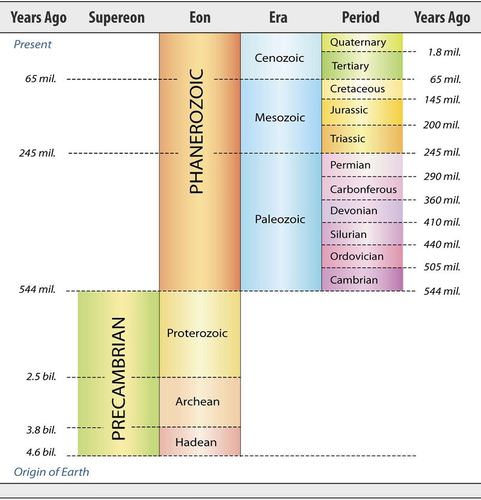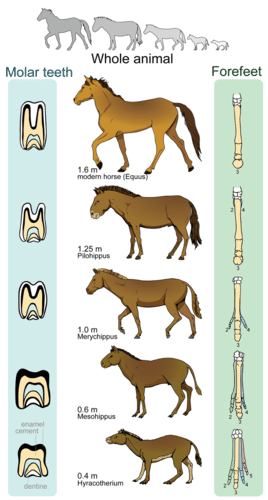READ: The Fossil Record
READ: The Fossil Record
How do we learn about the past?
We study the remains of things that existed many years ago. The Ruins of Pompeii have given archeologists, historians, and other scholars a tremendous amount of information about life two thousand years ago. This section discusses studying things that are many thousands of years older than these remains.
Earth in a Day
It’s hard to grasp the vast amounts of time since Earth formed and life first appeared on its surface. It may help to think of Earth’s history as a 24-hour day, as shown in the figure below. Humans would have appeared only during the last minute of that day. If we are such newcomers on planet Earth, how do we know about the vast period of time that went before us? How have we learned about the distant past?
History of Earth in a Day. In this model of Earth’s history, the planet formed at midnight. What time was it when the first prokaryotes evolved?
The Fossil Record
Much of what we know about the history of life on Earth is based on the fossil record. Detailed knowledge of modern organisms also helps us understand how life evolved. Fossils are the preserved remains or traces of organisms that lived in the past. The soft parts of organisms almost always decompose quickly after death. On occasion, the hard parts—mainly bones, teeth, or shells—remain long enough to mineralize and form fossils. An example of a complete fossil skeleton is shown below. The fossil record is the record of life that unfolded over four billion years and pieced back together through the analysis of fossils.
Extinct Lion Fossil. This fossilized skeleton represents an extinct lion species. It is rare for fossils to be so complete and well preserved as this one.
To be preserved as fossils, remains must be covered quickly by sediments or preserved in some other way. For example, they may be frozen in glaciers or trapped in tree resin, like the frog below. Sometimes traces of organisms—such as footprints or burrows—are preserved (see the fossil footprints below). The conditions required for fossils to form rarely occur. Therefore, the chance of an organism being preserved as a fossil is very low.
In order for fossils to “tell” us the story of life, they must be dated. Then they can help scientists reconstruct how life changed over time. Fossils can be dated in two different ways: relative dating and absolute dating. Both are described below.
- Relative dating determines which of two fossils is older or younger than the other, but not their age in years. Relative dating is based on the positions of fossils in rock layers. Lower layers were laid down earlier, so they are assumed to contain older fossils. This is illustrated below.
- Absolute dating determines about how long ago a fossil organism lived. This gives the fossil an approximate age in years. Absolute dating is often based on the amount of carbon-14 or other radioactive element that remains in a fossil.
Molecular Clocks
Evidence from the fossil record can be combined with data from molecular clocks. A molecular clock uses DNA sequences to estimate relatedness among species. Molecular clocks estimate the time in geologic history when related species diverged from a common ancestor. Species that have greater differences in their DNA sequences are assumed to have diverged from their common ancestor in the more distant past.
Consider the example in the table below. The table shows how similar the DNA of several animal species is to human DNA. Based on these data, which organism do you think shared the most recent common ancestor with humans?
| Organism | Similarity with Human DNA (percent) |
|---|---|
| Chimpanzee | 98 |
| Mouse | 85 |
| Chicken | 60 |
| Fruit Fly | 44 |
Geologic Time Scale
Another tool for understanding the history of Earth and its life is the geologic time scale, shown below. The geologic time scale divides Earth’s history into divisions (such as eons, eras, and periods) that are based on major changes in geology, climate, and the evolution of life. It organizes Earth’s history and the evolution of life on the basis of important events instead of time alone. It also allows more focus to be placed on recent events, about which we know the most.
Evidence of Animal Evolution
Evolution of the horse. Fossil evidence, depicted by the skeletal fragments, demonstrates evolutionary milestones.
The oldest horse fossils show what the earliest horses were like. They were about the size of a fox, and they had four long toes. Additional evidence in the rock layers shows they lived in wooded marshlands, where they probably ate soft leaves. Through time, the climate became drier, and grasslands slowly replaced the marshes. Later fossils show that horses changed as well.
- They became taller, which would help them see predators while they fed in tall grasses.
- They evolved a single large toe that eventually became a hoof. This would help them run swiftly and escape predators.
- Their molars (back teeth) became longer and covered with cement. This would allow them to grind tough grasses and grass seeds without wearing out their teeth.
Evidence of Plant Evolution
Evolution of plants can also be found in the fossil record. As shown in the, plants are thought to have evolved from an aquatic green alga protist. Later, they evolved important adaptations for land, including vascular tissues, seeds, and flowers. Each of these major adaptations made plants better suited for life on dry land and much more successful.
From a simple, green alga ancestor that lived in the water, plants eventually evolved several major adaptations for life on land.
Summary
- Much of what we know about the history of life on Earth is based on the fossil record.
- Molecular clocks are used to estimate how long it has been since two species diverged from a common ancestor.
- The geologic time scale is another important tool for understanding the history of life on Earth.
- Plants evolved several major adaptations for life on land.







